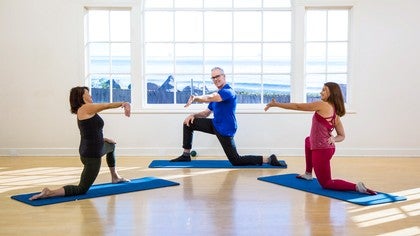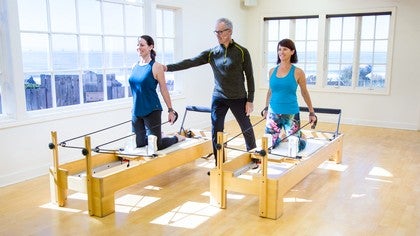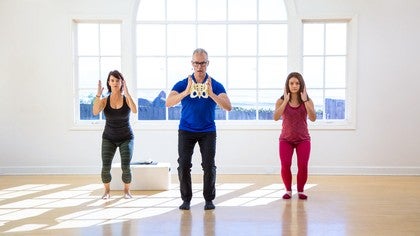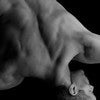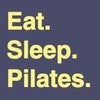Description
About This Video
Transcript
Read Full Transcript
Hi everybody. I'm Tom McCook back here at [inaudible]. Any time we're going to do a lesson today on the hip flexors. I'm here with Aaron and JD and um, you know, we've all talked about the hip flexors a lot is pull out his teachers and just in general how people live their lives with a lot of sitting, they can become tight and weak and affect our posture and how we move. So there's three primary ones that we're going to focus on, even though there's more than three. This four actually that we're going to work on. The three key ones are the, so as major, the so as minor, the Iliacus. And then the fourth one, which goes over your knee joint also is the rectus for Morris.
So we're just gonna do a little trace of those on our body. But before we do that, just think of what is hip flection mean. Let's just march in place for a moment. Here's hip flection. Now hip flexion is also, if you hinge the pelvis over your legs, do that a couple times. That's inflection. So hip flection can come from the pelvis on the legs or the legs on the pelvis.
And that affects the hip flexors pretty directly. Now the hip flexors run the, so as major and the Iliac, this run from what's called your lesser tr canter, which is on the inner upper femur over your pubic bone. And this red one right here is the ILIAC as and it goes inside the bowl of the pelvis. And it basically is your primary hip flexor. So you can think, wow, why do I have a so ass? Because when you lift the leg, a lot of times because of the weight of the leg, when you hit flex, if it was just the Iliac is doing that, the way that the leg could pull the lumbar spine and the pelvis anterior. So you can think, you can think, okay, what is my soul as doing so you're so as along with the assisting and hip flection is kind of a complex function, but it also is a lumbar stabilizer. So you can imagine that you are so as, which is this spotted want to do to know that your size was orange and spotted. It actually can hold the lumbar spine like a stack of envelopes and when it contracts it grabs on and so when you lift the knee, it's helping to stabilize the lower back and we want to get that to function a little better. Now this last guy, this blue guy, this thin one is called the so as minor and it goes from the pubic bone all the way up to t 12 and it's a thin muscle and it's underneath your organs.
So we've been trained and we all do this a lot in exercise, is to try to position the pelvis by just using our abdominal wall. If you hold your abs tight, it inhibits breathing and your hip flexors can be weakened. So we want to do is we want to improve the function of the hip flexors so then we can use the abdominal appropriately for bracing when it's necessary, but more for movement. Now, the last guy is the rectus for Morris, and it attaches on the anterior ILIAC spine, which is in the front of the pelvis. It's a very long muscle, goes down and crosses over the knee joint and ties into the Patella tendon with the rest of the other quadricep muscles. So we're just going to trace from an energetic flow what these guys do. So with a, we're gonna focus first on the, so as major, so just put your fingers right next to your belly button.
Just imagine right behind your hands. Straight back on the spine is where the cell as attaches to the bodies of the Vertebra, the sides of the Vertebra, The v, the the discs, and the transverse processes, and just trace down to your inner thighs, over your pubic bone. And just imagine the flow is down or we want to get this guy to come more online because it tends to be a little inhibited. There we go. And now same attachment. The ILIAC is Elio, so as same attachment on the less richer canter, that's your main hip flexor. We're gonna think of, Oh, we just lost a little bit of our hip flexor.
We're gonna imagine up from the inner and then out. And this guy tends to be tight. So we want to get it to lengthen so we can release tension to the pelvis, can be in a better position. So it's from Lester der up and out.
Easefully and now we're going to take all that imagery and flows and some exercises on the mat using the Franklin balls. So I'm going to remove this out of our way right now. So you guys are going to grab the Franklin balls and come on to your back with your feet facing me. And we're going to put the Franklin balls behind the pelvis on each side of your sacrum, about the width of your sit bones. Beautiful.
Then have your feet in line with your sit bones and just take a moment just to take a few breaths to settle into gravity. And the first movement we're going to do is just arch curl of the pelvis. Now just practice tipping your pelvis forward, meaning let the tail go towards the floor, so you're going to arch the lower backs. Now when you're doing that, you're shortening the ILIAC IHSS. It's sliding together the Ma, the muscle that removes over your pubic bone to your inner thigh. When you curl back, it's lengthening a little bit and just do that nice and slow.
And this is the first version. It's not a big stretch because your legs are bent, but it gets you a little bit, just touched a warm up and you can also notice when you curl towards the ceiling that the bottom of the pelvis narrows for the pelvic floor and the lower back are actually working together actually in opposition. So when you curl is the pelvic floor, shortens the lower back Lincolns and as you arch the pelvic floor lengthens the lower back shortens.
Don't pull the knee in close to your chest, leave it pretty far away. Just focus on the pelvis, curling towards the ceiling tail towards the ceiling. Other way. There you go. Now inhale, tip it forward. That's it. And just go back and forth and picture. You're lengthening the hip flexor on the down leg side.
Can you guys sense that a little bit? That's it. And that's tying all the way down to your inner thigh. And the key thing with stretching your hip flexors is you don't want to work hard in your shoulders and neck. We inhibit her hip flexes with neck and shoulder tension. Do One more on that side and now then the down leg and switch sides.
I highly recommend that when you practice that you do something to release your hip flexes. Before you do any deep core work. Have you been sitting all day and your hip flexors are inhibited? You can do a lot of abdominal work and your back. It's more compressed. So first thing with the leg long, curl the tail towards the ceiling, then release the tail forward. And imagine the muscle is lengthening from the inner upper thigh over the pubic bone to the inside of the pelvic wall.
And just sense that for a few breaths like that, exhale the curl. Leave your knee you're holding still so you're not actually pulling on that knee at all. You're just holding it there so it makes it easier for you to support the position of your lower back. And do one more. Very nice. Now coming back to the first leg, you're gonna hold the right leg again. Now we're going to work on a little more focus on your so as even though all of them are subtly being affected now hold this leg in that with both hands now and draw it in with your left leg.
Draw it in like you're developing the needs right in on its own. Reach it up to the ceiling with the left leg. Reach the left leg. Hold this leg, draw this leg in on its own can reach it straight up now long exhale. Let it lower towards the floor. Now imagine you're using that leg as a weight. Now to lengthen the muscles that attach from your spine to your inner thigh and then bend it back in. Reach it up on a long exhale as it lowers. Imagine your lower back is melting towards the floor. That's it.
Nice and smooth like that. Feel like you don't need to brace in your belly, especially. Don't brace it in your neck and your shoulders and just sense that you're using the leg now as a weight. And don't think you need to tense your foot. Do any of that. Your foot, you're just using the weight of your leg to centric. Sensically. Lengthen your deeper hip flexor muscles. Do that one more time. I would do anywhere from
So what we want to do is move from where the legs meet the body. So without engaging your lower legs at all. Let one do you come closer to your chest. When you go towards the floor and feel like you're just hinting, and when you do that, just imagine as you move like that that you can start to breathe a little deeper. You can relax the lower belly and keep your knees tracking right over the center of the hip joint and now just cart to go a little quicker.
Nice and fluid. Still breathing low and deep. Now even touch your lower belly and notice is it possible while you're doing this to not overly brace your lower belly and can I breathe even a little deeper while I'm doing it? Movement and breath. We want it to go together. Couple more. Now come a little slower, a little slower. Now as you come to a halt, leaving your fingers in your belly, imagine your goal is to notice kind of relax my belly and let both knees go towards the floor and then lifting.
Don't think the goal that you have to touch the floor go to where you can go with the lower back isn't going with the legs, not by bracing though. Image. The hip flexors are sliding apart, then they're sliding together and just go nice and fluid. If you have to make it really small, that's fine. You're trying to restore function of that area. If you overly brace in the belly, we skip it.
That's it. One more. And then gently place one foot down your second leg, lift your hips and take the balls away. And just take a moment to notice how the lower back feels. My notice is a little longer, a little more on the, and I just even do a simple bridge. Now, just curl off the floor. Take a breath. Now soften the breastbone and lengthen back down.
You might notice that it's easy to articulate the back. The exercise just feels generally easier. So now from there you guys are going to draw your knees into your chest and we're going to come up to standing and do a couple of close chain standing. That was all open chain. So we'll come on up to standing. Very nice you guys. So for this position we're going to take, and this ties back to what we did in gate in another lesson, we're going to step your left foot forward, right foot back, and only have about one foot's distance between your feet front to back and about six inches left to right now just practice.
All I want you to do is to practice taking your center of mass, which is a little below the belly button on a diagonal towards your left foot as you bend your front knee. Now hold it there. And what I'd like you to do is just practice reaching into your back foot and feeling the big toe ball of the foot and the little toe ball of the foot on that back leg. And just sense that for a moment. Now just notice all I want you to do here is straight in the back knee. That's now all we're going to do. We're going to focus on the ILIAC. This right here.
So I want you to shift your pelvis a little more to the left and fail. That's kind of creating a little more of an opening in that back hip. Now all we're going to do here is on the exhale post dearly, tip your pelvis, take your tail forward as you press into your back foot and then release it. It's okay to let the, he'll be a little bit off the ground, but you're not losing the back foot. And you'll notice the tendency be want to bend the knees, keep the legs straight and feel that flection where you're opening the hip, but you're keeping the legs strong.
And this relates to a part of the gait cycle called shift. Now we're going to add something to it. So as you curl to add a little more flection internally, rotate the arms, sync your ribs in and lift your Chin and then release it. And again, so it's pelvis tips back rib sink in internal rotation. One more time and release. Now from there, are you going to stay on that same side? You're just gonna lower the back knee to the mat.
Now with the back knee. Again, have that same gap left to right and with the back foot untuckit and let the foot go a little wider than the knees. Leg goes a little bit internal. Puts your right hand against your, your front of your belly, left hand on your lower back and square your hips to the front of your mat. Now all you're going to do is just practice taking the tail forward, tail back. You start to feel how that, now we're getting a little more into the ILIAC, this, but also the rec fem, the muscle that runs down the front of the thigh. That's it. Now when you curl forward this next time, hold it, contract your glued on that back leg and put your left hand on your front knee.
Now let your spine side bend a little to the left. Let your spine rotate a little towards the back leg. Now stay there. Take the backside arm straight off your shoulder on that diagonal with the fingers facing down. Now press through the heel of your hand. Pull back through your waist and as you breathe, breathe the length of your spine for five big breaths.
Keep taking the tail forward. Waistline back.
Now with your back leg, press into you two front foot points, big toe, little toe and let the pelvis shift a little more to the right. Now straighten that back leg. Now as you exhale, curl the tail forward and then release it and feel when you're curling forward is when you're feeling the stretch. Do your best to keep the back knee straight cause it might want abandon. If you feel like you can't do it without bending the back knee, step your feet closer together, front to back. Now as you hold it, this was just the gait cycle right here. Hold it. Ribs drop in, tail forward, arms internally rotate should even feel a contraction in your laps right now. The muscles that connect your arms to your pelvis. Inhale, release. Exhale, let the chin lift, which isn't what we tend to think about, but this is what happens when you walk on the spine is flexing the pelvis and head are tipping in the same direction as the spine in the middle is tipping the other way. One more.
Now gently drop your back knee to the floor. Tuck the back toes, take the foot a little wider, puts your right, our left hand on your lower belly, right hand your lower back and square your hips to the front of your mat. Now just shift your hips a little bit to your right. As you start to feel how you're getting a little stretch in your inner thigh muscles. To now just exhale tail forward tailback and sense how the posterior tip is stretching the hip flexor muscles. Now hold the posterior, puts your right hand on your knee. Now side bend in your lower back.
Rotate towards the back leg. Now take that back leg left arm straight off your shoulder on a diagonal. Fingers down a press forward through the heel of your hand. Pull back through the waist and just breathe the length your spine. No need to hold your belly. Three more breaths.
I recommend practicing them. Then you can put them into your mat classes. You can give them to your clients from when they're sitting a lot or just with your own body and just let us know how that goes for you. I hope you enjoyed. Thank you plots anytime. Thank you guys.
The Teacher's Corner: Embrace How You Teach
Comments
You need to be a subscriber to post a comment.
Please Log In or Create an Account to start your free trial.
